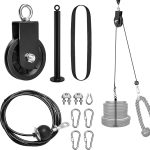Do you ever feel like you’re putting in all the effort at the gym but not seeing the results you want on the scale? In this blog post, we dive into the age-old question: Can strength training really help with weight loss? Join us as we explore the potential benefits of incorporating strength training into your fitness routine and uncover the truth behind its role in achieving your weight loss goals.



What is Strength Training?
Strength training is a type of physical exercise that uses resistance to build strength, endurance, and muscle mass. This form of training involves using external resistance such as weights, resistance bands, or body weight to challenge your muscles. Unlike cardiovascular exercises like running or biking, strength training focuses on improving your muscular strength and power.
How Does Strength Training Differ from Other Forms of Exercise?
- Focus on Resistance: Strength training emphasizes the use of resistance to build muscle and strength, while other forms of exercise like cardio focus on improving cardiovascular health.
- Targeted Muscle Groups: Strength training allows you to target specific muscle groups and work on muscle imbalances, unlike more general forms of exercise.
- Progressive Overload: Strength training involves progressively increasing the resistance or volume of your workouts to continue challenging your muscles and seeing improvements.
Benefits of Strength Training Beyond Muscle Building
- Improved Bone Health: Strength training helps increase bone density, reducing the risk of osteoporosis and fractures.
- Increased Metabolic Rate: Building muscle through strength training boosts your metabolism, helping you burn more calories even at rest.
- Enhanced Functional Strength: Strengthening your muscles through targeted exercises can improve your ability to perform daily tasks with ease.
- Injury Prevention: Strong muscles and connective tissues can help prevent injuries and improve overall joint health.
- Enhanced Athletic Performance: Strength training can improve power, speed, and agility, benefiting athletes in various sports.
Practical Examples and Product Recommendations
To start strength training at home, consider investing in the following products:
- Bowflex SelectTech Adjustable Dumbbells: These adjustable dumbbells allow you to easily change the weight for different exercises, saving space and money compared to buying multiple dumbbells.
- TRX Suspension Trainer: The TRX system uses your body weight as resistance and is versatile for a wide range of strength training exercises, making it suitable for home workouts.
- Fit Simplify Resistance Loop Exercise Bands: These resistance bands offer a convenient way to add resistance to your workouts, ideal for targeting different muscle groups and accommodating various fitness levels.
Impact on Weight Loss
In the quest for weight loss, many people focus on cardio exercises like running, cycling, or swimming. While cardio is undoubtedly beneficial for burning calories, strength training is often overlooked as a powerful tool for weight loss. Let’s delve into the scientific evidence supporting the role of strength training in shedding those extra pounds.
Muscle Mass and Metabolism
One key benefit of incorporating strength training into your weight loss regimen is its impact on muscle mass. When you engage in strength training, you stimulate the growth and maintenance of muscle tissue. Unlike fat tissue, muscle is metabolically active, meaning it burns calories even at rest.
Boosting Metabolism
- Product Example: Bowflex Home Gym
- Strength training helps increase muscle mass, which in turn boosts your basal metabolic rate (BMR).
- A higher BMR means your body burns more calories throughout the day, even when you’re not working out.
Burning Calories
- Product Example: PowerBlock Adjustable Dumbbells
- Muscles require energy to function, so the more muscle mass you have, the more calories your body burns during exercise and at rest.
- Strength training can lead to an “afterburn effect,” where your body continues to burn calories post-workout to repair and rebuild muscle tissue.
Scientific Studies
Numerous scientific studies have demonstrated the positive impact of strength training on weight loss. For example:
- A study published in the Journal of Applied Physiology found that participants who incorporated strength training into their exercise routine lost more body fat than those who focused solely on cardio.
- Another study in the International Journal of Obesity showed that combining aerobic and resistance training was more effective for weight loss than aerobic training alone.
Practical Tips for Incorporating Strength Training
To make the most of strength training for weight loss, consider the following tips:
- Start Slow: Begin with lighter weights and gradually increase the resistance as you build strength.
- Consistency is Key: Aim for at least two to three strength training sessions per week to see results.
- Mix It Up: Incorporate a variety of exercises targeting different muscle groups for a well-rounded workout.
By including strength training in your weight loss journey, you can enhance your metabolism, burn more calories, and achieve your fitness goals more effectively. So, next time you hit the gym or workout at home, don’t forget to pick up those weights and feel the difference in your body composition and overall health.
Designing a Strength Training Program for Weight Loss
Incorporating strength training into your weight loss regimen can significantly boost your results. By building lean muscle mass, you increase your metabolism and burn more calories even at rest. Designing an effective strength training program is key to achieving your weight loss goals. Here are some tips and guidelines to help you create a successful program tailored to your needs:
Frequency
- Aim to strength train at least 2-3 times per week to allow for proper muscle recovery and growth.
- Include a mix of full-body workouts and targeted muscle group sessions to ensure balanced development.
- Ensure you have at least one rest day between strength training sessions to prevent overtraining and aid in muscle repair.
Intensity
- Focus on high-intensity workouts that challenge your muscles and elevate your heart rate.
- Use weights that are heavy enough to fatigue your muscles within 8-12 repetitions for optimal muscle growth and calorie burn.
- Incorporate progressive overload by gradually increasing the weight or intensity of your workouts to continue seeing results.
Types of Exercises
- Compound exercises like squats, deadlifts, lunges, and bench presses engage multiple muscle groups simultaneously, maximizing calorie burn and muscle development.
- Include bodyweight exercises such as push-ups, pull-ups, and planks to build functional strength and improve overall fitness.
- Incorporate cardiovascular activities like kettlebell swings, battle ropes, or box jumps to add a cardio element to your strength training routine.
Practical Examples
- Dumbbells: Opt for adjustable dumbbells like the Bowflex SelectTech series, which allow you to easily change weights for different exercises.
- Resistance Bands: Consider using Fit Simplify Resistance Bands to add variety and resistance to your workouts, especially for home-based training.
- Kettlebells: Brands like CAP Barbell offer a range of kettlebells suitable for different fitness levels and exercises.
By following these tips and guidelines, you can design a strength training program that supports your weight loss journey effectively. Remember to listen to your body, stay consistent, and gradually progress to achieve long-lasting results.
Combining Strength Training with Cardio
In the pursuit of a healthier lifestyle, many individuals often find themselves torn between focusing solely on strength training or dedicating their time to cardiovascular exercises. However, the truth is that incorporating both forms of exercise into your routine can yield significant benefits for overall weight loss and fitness. Let’s delve into the advantages of combining strength training with cardio and explore some practical tips on how to strike the perfect balance in your workout regimen.
Benefits of Combining Strength Training with Cardio
1. Accelerated Weight Loss
- Product Example: Fitbit Versa 3 Smartwatch
- Utilizing a fitness tracker like the Fitbit Versa 3 can help you monitor the calories burned during both strength training and cardio sessions, enabling you to create a more effective weight loss plan.
2. Increased Metabolism
- Product Example: Bowflex SelectTech 552 Adjustable Dumbbells
- Incorporating strength training with dumbbells like the Bowflex SelectTech 552 can help boost your metabolism, allowing your body to continue burning calories even after your workout ends.
3. Enhanced Muscle Tone
- Product Example: Nike Air Zoom Pegasus 38 Running Shoes
- Pairing your strength training routine with running using the Nike Air Zoom Pegasus 38 can contribute to improved muscle definition and overall body tone.
4. Improved Cardiovascular Health
- Product Example: Concept2 Model D Indoor Rowing Machine
- Engaging in cardio exercises such as rowing with the Concept2 Model D can enhance your heart health, promoting better circulation and endurance.
Tips for Balancing Strength Training and Cardio
1. Alternate Between Workouts
- Create a schedule that alternates between strength training and cardio sessions to prevent overtraining and allow your muscles to recover adequately.
- Product Example: TRX Suspension Trainer
- Consider incorporating a versatile tool like the TRX Suspension Trainer to add variety to your strength training routine while improving core stability.
2. Integrate High-Intensity Interval Training (HIIT)
- Combine bursts of intense cardio exercises with strength training intervals to maximize calorie burn and improve both cardiovascular fitness and muscle strength.
- Product Example: Peloton Bike+
- Join virtual HIIT classes using the Peloton Bike+ to experience a dynamic workout that seamlessly blends cardio and strength training.
3. Listen to Your Body
- Pay attention to how your body responds to the combined workouts and adjust the intensity and frequency based on your fitness level and recovery needs.
- Product Example: Theragun Elite Percussive Therapy Device
- Use a recovery tool like the Theragun Elite to alleviate muscle soreness and enhance post-workout recovery, ensuring you can maintain a consistent exercise routine.
By harmoniously integrating strength training and cardiovascular exercise into your fitness regimen and following these practical tips, you can optimize your weight loss journey and achieve a well-rounded level of fitness.
Final Thoughts
Conclusion:
Strength training is an essential component in achieving weight loss goals as it enhances metabolism, builds muscle mass, and aids in sustainable weight management. For optimal results, combining strength training with a well-rounded diet and cardio regimen is key.
















